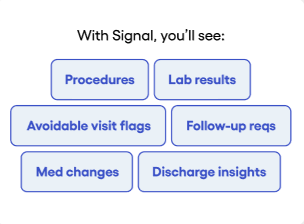Transitions of Care: Power Care Transitions with Signal Alerts
See how nationwide, context-rich Signal alerts fuel timely, impactful interventions that improve care and reduce costs during transitions of care.




Power Transitions of Care with Signal from Particle Health
Welcome to the final article in our transitions of care series. In our previous post, we highlighted the shortcomings of admission, discharge and transfer (ADT) feeds in supporting timely, effective interventions during transitions of care. Now, we’ll:
- Introduce Particle Health’s Signal offering
- Explain how Signal alerts outperform ADT data feeds
- Explore what improved coverage, clinical context and actionability look like
Introducing Particle Signal
Particle Health’s Signal offering is designed to transform the way organizations navigate transitions of care. Signal doesn’t simply alert care teams to patient movement. It delivers nationwide coverage and clinical context care teams need to proactively support patients and their caregivers.
What Signal Adds to the Equation
ADT feeds have two persistent shortcomings: Coverage is fragmented, forcing organizations to stitch together multiple ADT vendors or state health information exchanges (HIEs) only to achieve partial visibility; and clinical context provided in ADT alerts can be limited.
Signal closes these gaps, acting as a single, more complete source of truth and giving care teams a smarter foundation for action. It allows organizations to support transitions of care and respond to events in near-real time — which is especially necessary for understanding patient and caregiver needs, informing treatment and care plan updates.
Coverage: A Single, Nationwide Solution — Not a Patchwork
Missed events mean missed opportunities for patient engagement, quality care and value. In a direct comparison for a VBC provider using 6+ ADT feeds—including an aggregator and multiple state HIEs—Signal identified nearly 25% more inpatient and emergency events than standard ADTs. State exchanges may offer strong regional coverage, but for patients who travel out of state or are otherwise outside of that patchworked network of connections, their events may go unrecognized.
Signal is built on a national network across 90% of CMS hospitals and extensive SNF facilities. This comprehensive coverage provides access to 320M+ patient medical records — and all via one connection.
No need for multiple contracts across ADT or other complicated data feeds, no overlapping systems. Just one simple solution that empowers care teams to focus on those experiencing vulnerable transitions.
Context: Trade Basic Alerts For Deep Understanding
Most raw ADT alerts confirm that something happened. Signal suggests what happened. Each Signal notification is enriched with structured, clinical context drawn directly from nationwide and state HIE networks, along with pharmacy alerts.
Instead of waiting days for discharge documentation or calling for records, care teams receive a timely, contextualized view of each patient’s clinical status—including inpatient procedures, medications, discharge summaries, and follow-up instructions. In fact, Signal delivers visibility into 75% of discharges within 48 hours, ensuring teams can act while the information is still actionable.
Signal also associates clinical metadata with episodes of care, removing the need to piece together information from multiple sources. Longitudinal data is accessible through the same platform, so care teams always have the historical patient journey in view.
Building on this, Particle’s proprietary AI surfaces user-specific insights such as summaries of visits, previous hospitalizations or urgent events, medication fill status and eligibility for care management programs.
The result is a comprehensive and actionable insight of the event, plus relevant patient history delivered in near-real time — all without the burden of manual data gathering. No more chasing faxes, thumbing through pages of clinical notes or digging into CCDAs to reconstruct what happened. Medication reconciliation, transitional care management, and post-discharge workflows are enabled, with the context care teams need to provide care.
Actionability: From Reactive to Proactive Care
Coverage and context only matter if teams can act on them — and Signal was built for action. Take Medication Reconciliation, for example, when a clinician compares a list of recently started, stopped or changed medications with the prior medication list. Historically, care teams have gathered this data via laborious and error-prone methods, including:
- Asking patients to share their pill bottles
- Deciphering a handwritten medication list
- Requesting records from facility EHRs and/or pharmacies
With Signal, care teams can simply reference the medication changes directly in the alert’s linked discharge summary. They can further contextualize the changes by referencing parsed conditions, procedure, and lab results. And finally, by applying AI-powered insights, Signal can highlight encounter and/or patient level details, such as encounter-level medication summaries. With Signal, care teams can lean on parsed, curated outputs while focusing on their patients.
In addition to care coordination support, these AI capabilities can be used for additional workflows — from summarization of visits, to quality care gap closure, to assessment of care program eligibility.
The depth and breadth of clinical data on the national networks make Signal particularly effective for monitoring patients at scale. Signal, with AI summarization, can enable care teams to intervene and coordinate more efficiently and effectively.

Unlike traditional ADTs, Signal delivers notifications that have deep clinical context under the hood, but mirror the structure of ADT feeds, fitting seamlessly into existing workflows. No heavy integration required.
In Closing
Transitions of care may continue to be complex. But with Signal they no longer have to be blind, fragmented or reactive. By enriching ADT alerts with deep clinical insight or replacing them completely, Particle Health empowers care teams to move from standard alerts to differentiated insights and true actionability.
Signal provides a smarter foundation for continuity, quality and trust across the care continuum. Coverage care teams can rely on. Context that adds meaning. Actionability that supports outcomes.
Ready to see Signal in action? Contact our team to learn how we can help you transform transitions of care, one signal at a time.












